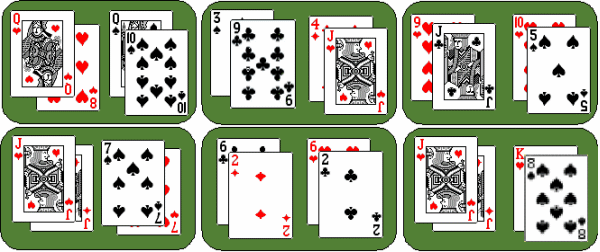Copyright
- Cards
- Fifty-two, ranking from high to low KQJ1098765432A in each suit. Aces are always lower than deuces.
- Deal
- Shuffle the cards thoroughly and deal seven to each player, face down and one at a time. Stack the remainder face down in a stock called the Can (if you like puns. If not, it's called the stock).
- Object
- To win 27 or more cards in tricks. Each trick consists of two cards from each player.
- Play
-
Non-dealer leads to the first trick and the winner of each trick leads to the next. The leader to a trick places two cards from
their hand on the table and announces either 'High' or 'Low'. The follower then plays out two cards from their hand and will seek (if
able and willing) to follow the same suit pattern.
There are three suit patterns:
If the leader declared ‘High’, the trick is taken by the two cards with the higher top card, or, if equal, the higher accompanying card.- Flush = two cards of the same suit
- Colour = two cards of the same colour (red or black) but different suits
- Mix = two cards of different colours (one red and one black)
If the leader declared 'Low' it is taken by the two cards with the lower bottom card, or, if equal, the lower accompanying card. (Ace is lowest, remember.)
Whoever plays the winning cards wins any three of the four cards played, the fourth going to the loser. They similarly win three cards if the follower fails to match the suit pattern, but nevertheless plays the highest or lowest card (as announced). The loser of the trick wins one card. (Note: If the suit pattern is 'colour', the two cards must be of different suits.)
If the follower neither matches the suit pattern nor plays the highest or lowest card (as announced), the leader wins all four cards and leads to the next trick.
If the follower both matches the suit pattern and ties by playing cards of identical ranks, both players win two of the four cards played and the follower leads to the next trick.
Before the next trick is led both players replenish their hands by drawing two cards from the Can, or one when only one remains, and thereafter none. - Pairs
- When leading, you may lead two cards of the same rank, as 8-8 or K-K, regardless of suit/colour composition, and announce either 'High' or 'Low'. If you announce ‘High’ the trick goes to whoever plays the higher-ranking pair, otherwise to whoever wins the lower-ranking pair, and that player wins three of the four cards played. If both play pairs of equal rank, they win two cards each and the follower leads to the next trick. If the follower fails to play a pair, the leader wins all four cards, or three if the follower’s cards are of exactly the same suits as the leader’s.

Examples of play
(1) ![]() Q-8 led, wins if Low declared, else loses to
Q-8 led, wins if Low declared, else loses to
![]() Q-10;
Q-10;
(2) ![]() 3-
3-
![]() 9 led,
9 led,
![]() 4-
4-
![]() J: =
J: = ![]() 3 wins
if Low announced, else
3 wins
if Low announced, else ![]() J;
J;
(3) ![]() J wins if High declared, else
J wins if High declared, else
![]() 5;
5;
(4) ![]() J-
J-
![]() J led,
J led,
![]() 7-
7-
![]() 7 = Jacks win, but only three cards because Sevens match suits;
7 = Jacks win, but only three cards because Sevens match suits;
(5) ![]() 6-
6-
![]() 2 led,
2 led,
![]() 6-
6-
![]() 2 = tie, both win 2 cards;
2 = tie, both win 2 cards;
(6) ![]() J-
J-
![]() J led,
J led,
![]() K-
K-
![]() 8 = pair wins 4 cards.
8 = pair wins 4 cards.
- End
-
Play ceases when one player correctly claims to have won at least 27 cards. That player scores one game point for each card in excess
of the number of cards won by the loser. If the claim proves false, the other player scores 5 game points. If both players each win
just 26 cards then whoever reached it first scores 1 game point.
The cards are then thoroughly shuffled and dealt by whoever did not lead first in the previous game. - Game
- A game is won by the first player to reach a total of 10 score-points, or any other agreed number.
- Note
- When following to a trick you need not follow the same suit pattern if you think it preferable to keep hold of certain cards or to get rid of two that may not be of much use later. On the whole, you might prefer to retain pairs, or high or low cards as potential future trick-winners, and discard middling unpaired cards between, say, Five and Ten.